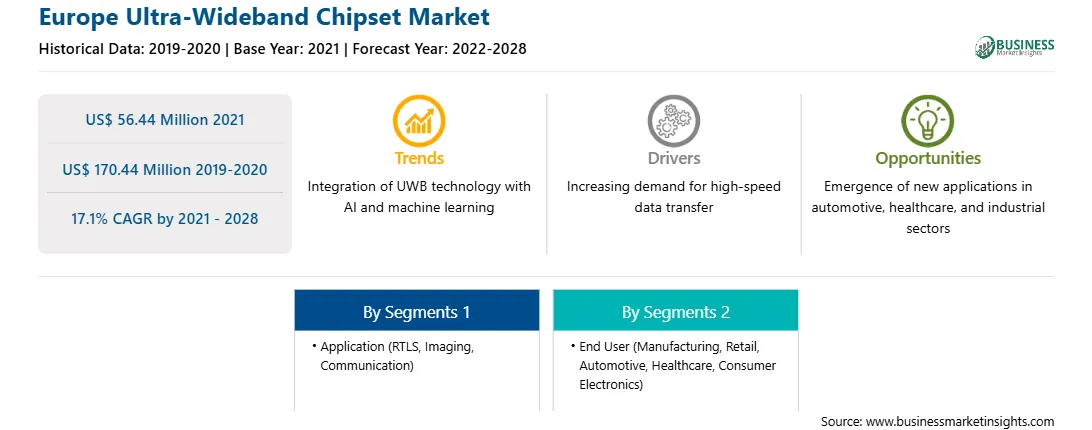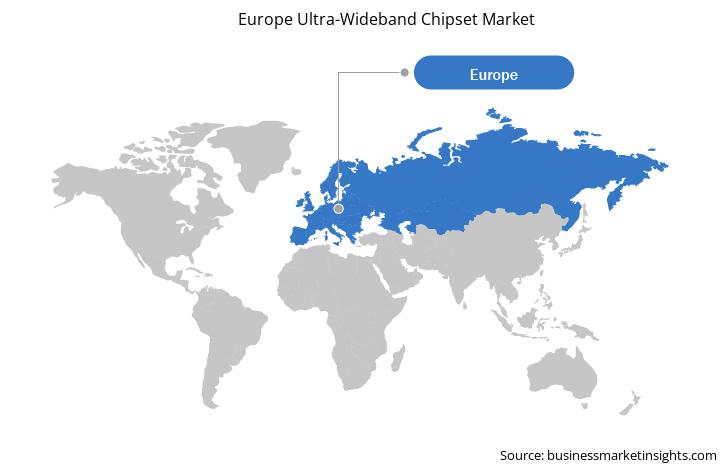UWB is the fastest-growing technology that is significantly improving consumers’ experience associated with home entertainment products, such as TV, laptop, and audio equipment. UWB enables the working of wireless connections at higher speeds, making it perfect for connecting television to home audio equipment. UWB supports less power-consuming and low-cost operations of devices. It is also being used in personal item tracking systems. For example, Apple designed a U1 chip enabled with the UWB technology for spatial awareness. It is integrated into iPhone 11, 12, and 13 series smartphones. Following Apple, various smartphone manufacturers have integrated UWB technology into their products. Moreover, in April 2021, Apple released AirTag supported by UWB, BLE, and NFC technologies, and post this, Samsung officially launched its Galaxy SmartTag+ tracker, comprising UWB and BLE technologies. SmartTag+ also enables artificial reality (AR) tracking as a part of its SmartThings service. Thus, the rising adoption of UWB technology in personal and consumer device tracking is bolstering the market growth.
The impact of COVID-19 varied from country to country across Europe, as selected countries witnessed a surge in number of confirmed cases and subsequently attracted stringent as well as longer lockdown periods or social isolation. However, western European countries such as Germany, France, Russia, and the UK witnessed a comparatively moderate decline in their production activities owing to their robust healthcare infrastructure. The European economy is expected to shrink by 0.1%, with a negative growth rate in the first half of the year 2020, followed by mild recovery in the second half of 2020. The imbalance in revenue generation of the companies and the lockdown phase in several European countries had a significant negative impact on the ultra-wideband chipset market in the first half of 2020. Factory shutdown, travel and trade bans, and border lockdown enacted by governments to combat and contain the outbreak hindered the growth of various markets in Europe. The automotive & transportation, healthcare, and consumer electronic sectors faced disruptions due to the shutdown of businesses. However, UWB is being projected highly for its high accuracy in contact tracing amid the COVID-19 outbreak. Thus, the overall impact of COVID-19 on the European region is low to moderate.
With the new features and technologies, vendors can attract new customers and expand their footprints in emerging markets. This factor is likely to drive the ultra-wideband chipset market in Europe during the forecast period.
Strategic insights for the Europe Ultra-Wideband Chipset provides data-driven analysis of the industry landscape, including current trends, key players, and regional nuances. These insights offer actionable recommendations, enabling readers to differentiate themselves from competitors by identifying untapped segments or developing unique value propositions. Leveraging data analytics, these insights help industry players anticipate the market shifts, whether investors, manufacturers, or other stakeholders. A future-oriented perspective is essential, helping stakeholders anticipate market shifts and position themselves for long-term success in this dynamic region. Ultimately, effective strategic insights empower readers to make informed decisions that drive profitability and achieve their business objectives within the market.

| Report Attribute | Details |
|---|---|
| Market size in 2021 | US$ 56.44 Million |
| Market Size by 2028 | US$ 170.44 Million |
| Global CAGR (2021 - 2028) | 17.1% |
| Historical Data | 2019-2020 |
| Forecast period | 2022-2028 |
| Segments Covered |
By Application
|
| Regions and Countries Covered | Europe
|
| Market leaders and key company profiles |
The geographic scope of the Europe Ultra-Wideband Chipset refers to the specific areas in which a business operates and competes. Understanding local distinctions, such as diverse consumer preferences (e.g., demand for specific plug types or battery backup durations), varying economic conditions, and regulatory environments, is crucial for tailoring strategies to specific markets. Businesses can expand their reach by identifying underserved areas or adapting their offerings to meet local demands. A clear market focus allows for more effective resource allocation, targeted marketing campaigns, and better positioning against local competitors, ultimately driving growth in those targeted areas.

The Europe Ultra-Wideband Chipset Market is valued at US$ 56.44 Million in 2021, it is projected to reach US$ 170.44 Million by 2028.
As per our report Europe Ultra-Wideband Chipset Market, the market size is valued at US$ 56.44 Million in 2021, projecting it to reach US$ 170.44 Million by 2028. This translates to a CAGR of approximately 17.1% during the forecast period.
The Europe Ultra-Wideband Chipset Market report typically cover these key segments-
The historic period, base year, and forecast period can vary slightly depending on the specific market research report. However, for the Europe Ultra-Wideband Chipset Market report:
The Europe Ultra-Wideband Chipset Market is populated by several key players, each contributing to its growth and innovation. Some of the major players include:
The Europe Ultra-Wideband Chipset Market report is valuable for diverse stakeholders, including:
Essentially, anyone involved in or considering involvement in the Europe Ultra-Wideband Chipset Market value chain can benefit from the information contained in a comprehensive market report.